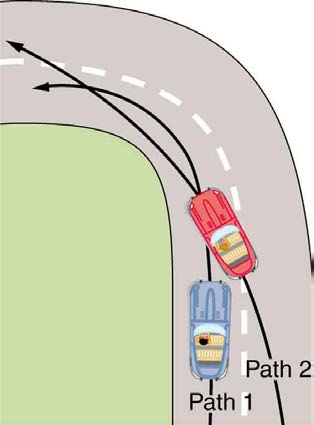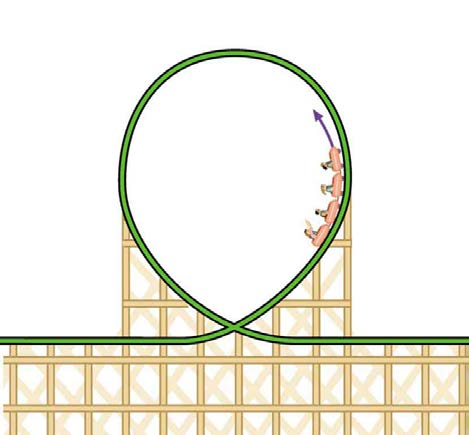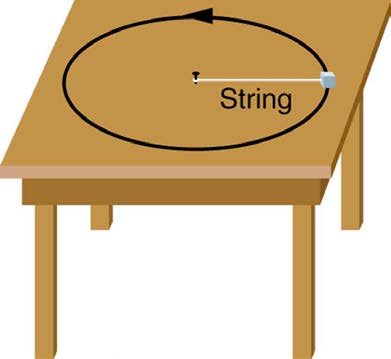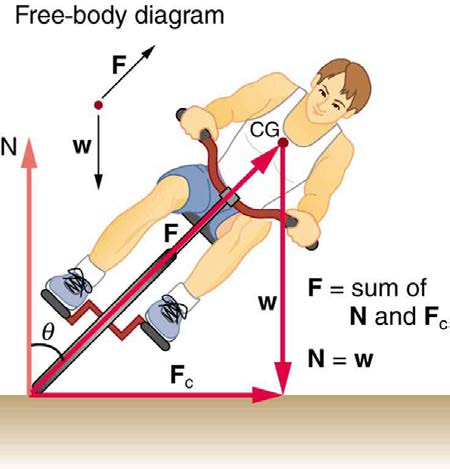the aid of friction between the tires and the road; the net external force on the vehicle equals the horizontal centripetal force in the absence of
friction
ideal speed: the maximum safe speed at which a vehicle can turn on a curve without the aid of friction between the tire and the road
microgravity: an environment in which the apparent net acceleration of a body is small compared with that produced by Earth at its surface
Newton’s universal law of gravitation: every particle in the universe attracts every other particle with a force along a line joining them; the force
is directly proportional to the product of their masses and inversely proportional to the square of the distance between them
non-inertial frame of reference: an accelerated frame of reference
pit:
a tiny indentation on the spiral track moulded into the top of the polycarbonate layer of CD
radians: a unit of angle measurement
radius of curvature: radius of a circular path
rotation angle: the ratio of the arc length to the radius of curvature on a circular path:
Δ θ = Δ s
r
ultracentrifuge: a centrifuge optimized for spinning a rotor at very high speeds
uniform circular motion: the motion of an object in a circular path at constant speed
CHAPTER 6 | UNIFORM CIRCULAR MOTION AND GRAVITATION 211
Section Summary
6.1 Rotation Angle and Angular Velocity
• Uniform circular motion is motion in a circle at constant speed. The rotation angle Δ θ is defined as the ratio of the arc length to the radius of
curvature:
Δ θ = Δ s
r ,
where arc length Δ s is distance traveled along a circular path and r is the radius of curvature of the circular path. The quantity Δ θ is
measured in units of radians (rad), for which
2π rad = 360º= 1 revolution.
• The conversion between radians and degrees is 1 rad = 57.3º .
• Angular velocity ω is the rate of change of an angle,
ω = Δ θ
Δ t ,
where a rotation Δ θ takes place in a time Δ t . The units of angular velocity are radians per second (rad/s). Linear velocity v and angular
velocity ω are related by
v = rω or ω = vr.
6.2 Centripetal Acceleration
• Centripetal acceleration a c is the acceleration experienced while in uniform circular motion. It always points toward the center of rotation. It is
perpendicular to the linear velocity v and has the magnitude
a c = v 2 r; a c = rω 2.
• The unit of centripetal acceleration is m / s2 .
6.3 Centripetal Force
• Centripetal force Fc is any force causing uniform circular motion. It is a “center-seeking” force that always points toward the center of rotation.
It is perpendicular to linear velocity v and has magnitude
F c = ma c,
which can also be expressed as
⎫
F c = mv 2 r ⎪
or
, ⎬⎪
F c = mrω 2 ⎭
6.4 Fictitious Forces and Non-inertial Frames: The Coriolis Force
• Rotating and accelerated frames of reference are non-inertial.
• Fictitious forces, such as the Coriolis force, are needed to explain motion in such frames.
6.5 Newton’s Universal Law of Gravitation
• Newton’s universal law of gravitation: Every particle in the universe attracts every other particle with a force along a line joining them. The force
is directly proportional to the product of their masses and inversely proportional to the square of the distance between them. In equation form,
this is
F = GmM
r 2 ,
where F is the magnitude of the gravitational force. G is the gravitational constant, given by G = 6.673×10–11 N ⋅ m2/kg2 .
• Newton’s law of gravitation applies universally.
6.6 Satellites and Kepler’s Laws: An Argument for Simplicity
• Kepler’s laws are stated for a small mass m orbiting a larger mass M in near-isolation. Kepler’s laws of planetary motion are then as follows:
Kepler’s first law
The orbit of each planet about the Sun is an ellipse with the Sun at one focus.
Kepler’s second law
Each planet moves so that an imaginary line drawn from the Sun to the planet sweeps out equal areas in equal times.
Kepler’s third law
The ratio of the squares of the periods of any two planets about the Sun is equal to the ratio of the cubes of their average distances from the
Sun:
T 2
3
1
T 2 = r 1 3,
2
r 2
where T is the period (time for one orbit) and r is the average radius of the orbit.
• The period and radius of a satellite’s orbit about a larger body M are related by

212 CHAPTER 6 | UNIFORM CIRCULAR MOTION AND GRAVITATION
T 2 = 4π2
GMr 3
or
r 3
T 2 = G
4π2 M.
Conceptual Questions
6.1 Rotation Angle and Angular Velocity
1. There is an analogy between rotational and linear physical quantities. What rotational quantities are analogous to distance and velocity?
6.2 Centripetal Acceleration
2. Can centripetal acceleration change the speed of circular motion? Explain.
6.3 Centripetal Force
3. If you wish to reduce the stress (which is related to centripetal force) on high-speed tires, would you use large- or small-diameter tires? Explain.
4. Define centripetal force. Can any type of force (for example, tension, gravitational force, friction, and so on) be a centripetal force? Can any
combination of forces be a centripetal force?
5. If centripetal force is directed toward the center, why do you feel that you are ‘thrown’ away from the center as a car goes around a curve? Explain.
6. Race car drivers routinely cut corners as shown in Figure 6.32. Explain how this allows the curve to be taken at the greatest speed.
Figure 6.32 Two paths around a race track curve are shown. Race car drivers will take the inside path (called cutting the corner) whenever possible because it allows them to
take the curve at the highest speed.
7. A number of amusement parks have rides that make vertical loops like the one shown in Figure 6.33. For safety, the cars are attached to the rails in such a way that they cannot fall off. If the car goes over the top at just the right speed, gravity alone will supply the centripetal force. What other
force acts and what is its direction if:
(a) The car goes over the top at faster than this speed?
(b)The car goes over the top at slower than this speed?


CHAPTER 6 | UNIFORM CIRCULAR MOTION AND GRAVITATION 213
Figure 6.33 Amusement rides with a vertical loop are an example of a form of curved motion.
8. What is the direction of the force exerted by the car on the passenger as the car goes over the top of the amusement ride pictured in Figure 6.33
under the following circumstances:
(a) The car goes over the top at such a speed that the gravitational force is the only force acting?
(b) The car goes over the top faster than this speed?
(c) The car goes over the top slower than this speed?
9. As a skater forms a circle, what force is responsible for making her turn? Use a free body diagram in your answer.
10. Suppose a child is riding on a merry-go-round at a distance about halfway between its center and edge. She has a lunch box resting on wax
paper, so that there is very little friction between it and the merry-go-round. Which path shown in Figure 6.34 will the lunch box take when she lets go? The lunch box leaves a trail in the dust on the merry-go-round. Is that trail straight, curved to the left, or curved to the right? Explain your answer.
Figure 6.34 A child riding on a merry-go-round releases her lunch box at point P. This is a view from above the clockwise rotation. Assuming it slides with negligible friction, will it follow path A, B, or C, as viewed from Earth’s frame of reference? What will be the shape of the path it leaves in the dust on the merry-go-round?
11. Do you feel yourself thrown to either side when you negotiate a curve that is ideally banked for your car’s speed? What is the direction of the
force exerted on you by the car seat?
12. Suppose a mass is moving in a circular path on a frictionless table as shown in figure. In the Earth’s frame of reference, there is no centrifugal
force pulling the mass away from the centre of rotation, yet there is a very real force stretching the string attaching the mass to the nail. Using
concepts related to centripetal force and Newton’s third law, explain what force stretches the string, identifying its physical origin.

214 CHAPTER 6 | UNIFORM CIRCULAR MOTION AND GRAVITATION
Figure 6.35 A mass attached to a nail on a frictionless table moves in a circular path. The force stretching the string is real and not fictional. What is the physical origin of the force on the string?
6.4 Fictitious Forces and Non-inertial Frames: The Coriolis Force
13. When a toilet is flushed or a sink is drained, the water (and other material) begins to rotate about the drain on the way down. Assuming no initial
rotation and a flow initially directly straight toward the drain, explain what causes the rotation and which direction it has in the northern hemisphere.
(Note that this is a small effect and in most toilets the rotation is caused by directional water jets.) Would the direction of rotation reverse if water were
forced up the drain?
14. Is there a real force that throws water from clothes during the spin cycle of a washing machine? Explain how the water is removed.
15. In one amusement park ride, riders enter a large vertical barrel and stand against the wall on its horizontal floor. The barrel is spun up and the
floor drops away. Riders feel as if they are pinned to the wall by a force something like the gravitational force. This is a fictitious force sensed and
used by the riders to explain events in the rotating frame of reference of the barrel. Explain in an inertial frame of reference (Earth is nearly one) what
pins the riders to the wall, and identify all of the real forces acting on them.
16. Action at a distance, such as is the case for gravity, was once thought to be illogical and therefore untrue. What is the ultimate determinant of the
truth in physics, and why was this action ultimately accepted?
17. Two friends are having a conversation. Anna says a satellite in orbit is in freefall because the satellite keeps falling toward Earth. Tom says a
satellite in orbit is not in freefall because the acceleration due to gravity is not 9.80 m/s2 . Who do you agree with and why?
18. A non-rotating frame of reference placed at the center of the Sun is very nearly an inertial one. Why is it not exactly an inertial frame?
6.5 Newton’s Universal Law of Gravitation
19. Action at a distance, such as is the case for gravity, was once thought to be illogical and therefore untrue. What is the ultimate determinant of the
truth in physics, and why was this action ultimately accepted?
20. Two friends are having a conversation. Anna says a satellite in orbit is in freefall because the satellite keeps falling toward Earth. Tom says a
satellite in orbit is not in freefall because the acceleration due to gravity is not 9.80 m/s2 . Who do you agree with and why?
21. Draw a free body diagram for a satellite in an elliptical orbit showing why its speed increases as it approaches its parent body and decreases as it
moves away.
22. Newton’s laws of motion and gravity were among the first to convincingly demonstrate the underlying simplicity and unity in nature. Many other
examples have since been discovered, and we now expect to find such underlying order in complex situations. Is there proof that such order will
always be found in new explorations?
6.6 Satellites and Kepler’s Laws: An Argument for Simplicity
23. In what frame(s) of reference are Kepler’s laws valid? Are Kepler’s laws purely descriptive, or do they contain causal information?
CHAPTER 6 | UNIFORM CIRCULAR MOTION AND GRAVITATION 215
Problems & Exercises
(a) What is its angular velocity in radians per second if it spins at 1200
rev/min?
6.1 Rotation Angle and Angular Velocity
(b) What is the linear speed of its tip at this angular velocity if the plane is
stationary on the tarmac?
1. Semi-trailer trucks have an odometer on one hub of a trailer wheel.
The hub is weighted so that it does not rotate, but it contains gears to
(c) What is the centripetal acceleration of the propeller tip under these
count the number of wheel revolutions—it then calculates the distance
conditions? Calculate it in meters per second squared and convert to
traveled. If the wheel has a 1.15 m diameter and goes through 200,000
multiples of g .
rotations, how many kilometers should the odometer read?
14. An ordinary workshop grindstone has a radius of 7.50 cm and rotates
2. Microwave ovens rotate at a rate of about 6 rev/min. What is this in
at 6500 rev/min.
revolutions per second? What is the angular velocity in radians per
(a) Calculate the centripetal acceleration at its edge in meters per second
second?
squared and convert it to multiples of g .
3. An automobile with 0.260 m radius tires travels 80,000 km before
wearing them out. How many revolutions do the tires make, neglecting
(b) What is the linear speed of a point on its edge?
any backing up and any change in radius due to wear?
15. Helicopter blades withstand tremendous stresses. In addition to
4. (a) What is the period of rotation of Earth in seconds? (b) What is the
supporting the weight of a helicopter, they are spun at rapid rates and
angular velocity of Earth? (c) Given that Earth has a radius of
experience large centripetal accelerations, especially at the tip.
6.4×106 m at its equator, what is the linear velocity at Earth’s surface? (a) Calculate the centripetal acceleration at the tip of a 4.00 m long
helicopter blade that rotates at 300 rev/min.
5. A baseball pitcher brings his arm forward during a pitch, rotating the
forearm about the elbow. If the velocity of the ball in the pitcher’s hand is
(b) Compare the linear speed of the tip with the speed of sound (taken to
35.0 m/s and the ball is 0.300 m from the elbow joint, what is the angular
be 340 m/s).
velocity of the forearm?
16. Olympic ice skaters are able to spin at about 5 rev/s.
6. In lacrosse, a ball is thrown from a net on the end of a stick by rotating
(a) What is their angular velocity in radians per second?
the stick and forearm about the elbow. If the angular velocity of the ball
(b) What is the centripetal acceleration of the skater’s nose if it is 0.120 m
about the elbow joint is 30.0 rad/s and the ball is 1.30 m from the elbow
from the axis of rotation?
joint, what is the velocity of the ball?
(c) An exceptional skater named Dick Button was able to spin much
7. A truck with 0.420 m radius tires travels at 32.0 m/s. What is the
faster in the 1950s than anyone since—at about 9 rev/s. What was the
angular velocity of the rotating tires in radians per second? What is this in
centripetal acceleration of the tip of his nose, assuming it is at 0.120 m
rev/min?
radius?
8. Integrated Concepts When kicking a football, the kicker rotates his
(d) Comment on the magnitudes of the accelerations found. It is reputed
leg about the hip joint.
that Button ruptured small blood vessels during his spins.
(a) If the velocity of the tip of the kicker’s shoe is 35.0 m/s and the hip
17. What percentage of the acceleration at Earth’s surface is the
joint is 1.05 m from the tip of the shoe, what is the shoe tip’s angular
acceleration due to gravity at the position of a satellite located 300 km
velocity?
above Earth?
(b) The shoe is in contact with the initially nearly stationary 0.500 kg
18. Verify that the linear speed of an ultracentrifuge is about 0.50 km/s,
football for 20.0 ms. What average force is exerted on the football to give
and Earth in its orbit is about 30 km/s by calculating:
it a velocity of 20.0 m/s?
(a) The linear speed of a point on an ultracentrifuge 0.100 m from its
(c) Find the maximum range of the football, neglecting air resistance.
center, rotating at 50,000 rev/min.
9. Construct Your Own Problem
(b) The linear speed of Earth in its orbit about the Sun (use data from the
Consider an amusement park ride in which participants are rotated about
text on the radius of Earth’s orbit and approximate it as being circular).
a vertical axis in a cylinder with vertical walls. Once the angular velocity
19. A rotating space station is said to create “artificial gravity”—a loosely-
reaches its full value, the floor drops away and friction between the walls
defined term used for an acceleration that would be crudely similar to
and the riders prevents them from sliding down. Construct a problem in
gravity. The outer wall of the rotating space station would become a floor
which you calculate the necessary angular velocity that assures the
for the astronauts, and centripetal acceleration supplied by the floor
riders will not slide down the wall. Include a free body diagram of a single
would allow astronauts to exercise and maintain muscle and bone
rider. Among the variables to consider are the radius of the cylinder and
strength more naturally than in non-rotating space environments. If the
the coefficients of friction between the riders’ clothing and the wall.
space station is 200 m in diameter, what angular velocity would produce
6.2 Centripetal Acceleration
an “artificial gravity” of 9.80 m/s2 at the rim?
10. A fairground ride spins its occupants inside a flying saucer-shaped
20. At takeoff, a commercial jet has a 60.0 m/s speed. Its tires have a
container. If the horizontal circular path the riders follow has an 8.00 m
diameter of 0.850 m.
radius, at how many revolutions per minute will the riders be subjected to
(a) At how many rev/min are the tires rotating?
a centripetal acceleration 1.50 times that due to gravity?
(b) What is the centripetal acceleration at the edge of the tire?
11. A runner taking part in the 200 m dash must run around the end of a
track that has a circular arc with a radius of curvature of 30 m. If he
(c) With what force must a determined 1.00×10−15 kg bacterium cling
completes the 200 m dash in 23.2 s and runs at constant speed
to the rim?
throughout the race, what is his centripetal acceleration as he runs the
curved portion of the track?
(d) Take the ratio of this force to the bacterium’s weight.
21. Integrated Concepts
12. Taking the age of Earth to be about 4×109 years and assuming its
Riders in an amusement park ride shaped like a Viking ship hung from a
orbital radius of 1.5 ×1011 has not changed and is circular, calculate
large pivot are rotated back and forth like a rigid pendulum. Sometime
the approximate total distance Earth has traveled since its birth (in a
near the middle of the ride, the ship is momentarily motionless at the top
frame of reference stationary with respect to the Sun).
of its circular arc. The ship then swings down under the influence of
gravity.
13. The propeller of a World War II fighter plane is 2.30 m in diameter.

216 CHAPTER 6 | UNIFORM CIRCULAR MOTION AND GRAVITATION
(a) Assuming negligible friction, find the speed of the riders at the bottom
of its arc, given the system’s center of mass travels in an arc having a
radius of 14.0 m and the riders are near the center of mass.
(b) What is the centripetal acceleration at the bottom of the arc?
(c) Draw a free body diagram of the forces acting on a rider at the bottom
of the arc.
(d) Find the force exerted by the ride on a 60.0 kg rider and compare it to
her weight.
(e) Discuss whether the answer seems reasonable.
22. Unreasonable Results
A mother pushes her child on a swing so that his speed is 9.00 m/s at the
lowest point of his path. The swing is suspended 2.00 m above the child’s
center of mass.
(a) What is the centripetal acceleration of the child at the low point?
(b) What force does the child exert on the seat if his mass is 18.0 kg?
(c) What is unreasonable about these results?
(d) Which premises are unreasonable or inconsistent?
6.3 Centripetal Force
Figure 6.36 A bicyclist negotiating a turn on level ground must lean at the correct
23. (a) A 22.0 kg child is riding a playground merry-go-round that is
angle—the ability to do this becomes instinctive. The force of the ground on the wheel
rotating at 40.0 rev/min. What centripetal force must she exert to stay on
needs to be on a line through the center of gravity. The net external force on the
if she is 1.25 m from its center?
system is the centripetal force. The vertical component of the force on the wheel
(b) What centripetal force does she need to stay on an amusement park
cancels the weight of the system while its horizontal component must supply the
merry-go-round that rotates at 3.00 rev/min if she is 8.00 m from its
centripetal force. This process produces a relationship among the angle θ , the
center?
speed v , and the radius of curvature r of the turn similar to that for the ideal
(c) Compare each force with her weight.








